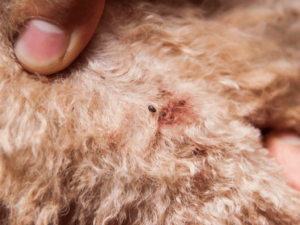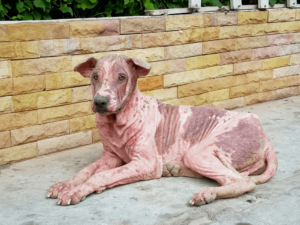Skin Tags on Dogs

As dog owners, we all want to ensure our furry companions are healthy and happy. However, sometimes our dogs can develop skin conditions that may cause us concern. One such condition is skin tags.
Skin tags are benign growths of fleshy tissue that can occur anywhere on a dog's body.
While they are usually harmless, it's important to understand what causes them and how to prevent them from developing.
In this article, we'll explore everything you need to know about skin tags on dogs and how to keep your furry friend healthy and comfortable.
Small, benign growths that protrude from the canine's skin, known as skin tags, are usually harmless and do not cause any discomfort to the pup. These flaps of tissue, which may resemble ticks, masses, warts, or cysts, are usually skin-colored or slightly darker and may appear anywhere on the body, though most commonly on the neck, head, eyelids, or armpits.
The cause of skin tags is unknown, although chronic irritation and pressure are suspected to be factors.
Dogs wearing tight collars or harnesses or those that sleep on hard surfaces may be more likely to develop these lumps and bumps.
Parasites such as fleas, ticks, and mites can also contribute to skin irritation and the growth of skin tags.

Though skin tags are not cancerous and are generally harmless, they can be unsightly and may cause the pooch to scratch or lick the area, potentially leading to infection or further irritation.
Proper skincare and grooming can help reduce the incidence of skin tags in canines.
If you notice any changes in the skin tag's appearance or the pup's behavior, it is important to seek veterinary attention.
Canines can often develop small, harmless growths anywhere on their body, but they are commonly found in certain areas such as the neck, head, eyelids, or armpits. Given that these regions are more exposed to friction and irritation, it is essential to keep an eye out for any changes in the dog's skin tags.
The chest is another common location for skin tags in dogs, as it is often a pressure point.

If your pup enjoys lying on his chest or wears constricting clothing like collars, harnesses, or jackets, they may be more prone to developing skin tags in that area. To avoid this, provide your dog with a soft, supportive bed and ensure any clothing they wear is not too tight.
The feet are yet another area where canine skin tags can occur. To reduce the risk, keep their feet free of dirt and debris and inspect them regularly for any signs of skin tags or other skin conditions. If your pup spends a lot of time outside or on rough surfaces such as concrete and gravel, it may be particularly susceptible to developing dog skin tags.
Skin tags on dogs are a common occurrence and can be attributed to a multitude of factors. From constricting collars and harnesses to parasites like fleas, ticks, and mites, chronic irritation can often be the root of such growth. To keep your pup's skin healthy and free from irritants, proper cleaning and maintenance are essential.
Moreover, genetics may also contribute to the likelihood of skin tags on dogs, with certain breeds – such as Boxers, hound breeds, bully-type terriers, English Bulldogs, and Pugs – being more prone to them. It is important to monitor any changes in their skin closely.
Furthermore, diet can also play a factor in the formation of such tags. Diets high in sugar and carbohydrates can cause inflammation in the body, which in turn, may lead to such growths. To prevent this, feed your pup a balanced and nutritious diet, free of artificial ingredients and high in protein.
Finally, age can also be a factor in the development of skin tags on dogs. As canines age, their skin loses its elasticity and becomes more prone to growth and tumors.
Although skin tags on dogs are usually harmless and often do not require treatment, it is still important to keep an eye on them and track any changes. In the event that the size, shape, or color of your pet's skin tags changes, be sure to take them to the vet for further evaluation.

Wondering if skin tags on their pup are dangerous? Good news - these growths are typically harmless and do not pose a major health hazard for the animal. Most dogs are unfazed by them unless they become sore or infected.
It's still important to keep an eye on the tags though, paying attention to any changes in size, color, or shape. If any of these occur or the tag appears infected, consulting a vet is the best approach.
Skin tags in dogs are often caused by persistent irritation and can be more common in specific breeds.
Though not life-threatening, they may still bring discomfort or look unpleasant. Removing them usually calls for a simple operation that can be done by a veterinarian. Removing the tag is not necessary unless it's causing problems.
In summary, skin tags in dogs are generally not a cause for concern. It's still advised to monitor them and seek veterinary help if there's any doubt about the animal's health.
Dogs usually tolerate skin tags without issue.
Particular canine breeds are more likely to contract skin tags than others, likely attributed to genetics and the breed's proneness to certain skin conditions. Breeds such as Boxers, hounds, bully-type terriers, English Bulldogs, and Pugs are commonly afflicted.
Though skin tags can develop in all dogs, those of these breeds should be particularly aware of their heightened risk and monitor for any signs of skin tag development.
In addition to genetics, other factors can bring about the emergence of skin tags in dogs. These include persistent irritation from collars or harnesses, pressure on the skin from lying on hard surfaces, and the existence of parasites such as fleas, ticks, and mites.
Therefore, owners of breeds predisposed to skin tags should ensure they take steps to ward off these contributors and promote healthy skin in their dogs.
This can include providing comfortable bedding, avoiding restrictive collars or harnesses, and maintaining good skincare practices including regular bathing and flea and tick prevention.
By taking a proactive stance on skin health, owners can help ensure their dogs remain free of skin tags.
To prevent skin tags in dogs, a multi-faceted approach must be taken that focuses on the root causes of skin inflammation. Providing soft, comfortable bedding that reduces pressure on the skin is a great way to help reduce chronic irritation, which can lead to benign growth. Furthermore, collars and harnesses that create friction and rub against the skin should be avoided, especially in areas that are prone to skin tags.
Good skincare is also key for preventing skin tags in dogs. Brushing and bathing regularly can help maintain healthy skin and ward off parasites such as fleas and ticks, which can cause intense itching and scratching, leading to skin irritation and the formation of benign growths. Additionally, using a vet-approved flea and tick preventative is also highly recommended.
It is important to be aware of your pup's breed and any potential predispositions to developing skin tags. Certain breeds, such as Boxers and English Bulldogs, are more likely to form benign growths.

If your dog is predisposed to skin tags, it is important to take proactive steps to prevent them, such as providing supportive bedding and practicing good skincare.
Also, regular check-ups with your vet can help ensure any skin tags that do develop are quickly identified and managed.
When it comes to treating growths on canines, the initial step is to make sure they are merely skin tags and not a more serious condition. A veterinarian can perform an examination and may even take a biopsy to ascertain the diagnosis. Once the tags are identified, treatment options can be explored.
A typical method for getting rid of skin tags is via a straightforward surgical procedure. The vet will administer a local anesthetic to numb the area around the tag and then cut it off.
This process is typically swift and painless, and most dogs recover rapidly. Another option is cryosurgery, which entails applying liquid nitrogen to the tag, freezing, and destroying the cells.
If neither surgery nor cryosurgery is viable, there are some home remedies that may assist with treating tags in dogs. A popular method is to tie a piece of dental floss tightly around the base of the tag, cutting off the blood flow. Over time, the tag will shrivel and detach. Nevertheless, it is essential to note that this technique can be agonizing for the pup and may not be appropriate for all tags.
If the growth is excised, the mass can be forwarded to a veterinary pathologist for cell analysis. Histopathology can differentiate between benign and malignant masses, as well as identify viral or bacterial growths.
While the majority of skin tags in dogs are non-cancerous, some may decrease in size spontaneously if left untreated. Despite the favorable prognosis for dogs with skin tags, it is important to monitor these growths for any changes. It is also worth noting that a dog with one skin tag may be predisposed to developing more.
Conclusion
In conclusion, skin tags in dogs are a common and usually harmless occurrence. While they may be unsightly or cause discomfort to our furry friends, they can be managed and prevented through proper care and attention.
As veterinarian Sarah Wooten advises, it is important to monitor any changes or signs of infection in your dog's skin tags and to seek veterinary care if necessary.
By providing a comfortable living environment, practicing good skincare, and avoiding irritants, we can ensure our dogs stay healthy and happy for years to come.




Leave a Reply